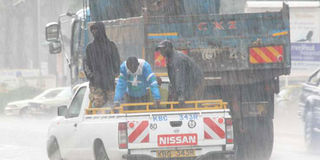Experts warn farmers of huge El Niño losses

Rain: Heavy rains pound Eldoret town on December 12, 2009. Weather experts on September 1, 2015 warned farmers of post-harvest losses and crop disease outbreaks during the El Niño rains. FILE PHOTO | JARED NYATAYA | NATION MEDIA GROUP
What you need to know:
- The director of National Disaster Operations Centre, Mr Nathan Kigotho, said the expected “above normal” rains will be 125 per cent more than Kenya gets during normal season.
- Mr Ambenje brushed aside predictions that the rains could be similar to those experienced in 1997/1998 when massive flooding caused damage worth $1.2 billion to crops and infrastructure.
Weather experts on Tuesday warned farmers of post-harvest losses and crop disease outbreaks during the El Niño rains.
Kenya Meteorological Service and other officials warned of possible destruction of infrastructure during the rains.
The director of National Disaster Operations Centre, Mr Nathan Kigotho, said the expected “above normal” rains will be 125 per cent more than Kenya gets during normal season.
Such high amounts of rain will result in flash floods and high moisture levels, promoting the breeding of disease-causing organisms.
“We are likely to have damages in infrastructure and are working with various ministries to mitigate the challenges that may arise,” Mr Kigotho told the media at the Kenya Meteorological Department offices in Nairobi’s Dagoretti.
“The rains will begin during the second or third week of October and end in late December, while some areas will experience downpours up to early January,” he said.
Kenya Meteorological Service Deputy Director Peter Ambenje said the rains could be a good motivation for farmers to reap maximum benefits.
He, however, warned that the rains could interfere with harvesting in the Rift Valley, especially in Trans Nzoia and “Farmers also need to be aware of the prevalence of diseases due to high moisture levels that may cause post-harvest losses,” he added.
Mr Ambenje brushed aside predictions that the rains could be similar to those experienced in 1997/1998 when massive flooding caused damage worth $1.2 billion to crops and infrastructure.
“We should not pay attention to claims ... We should provide factual information and avoid lying,” he said.
Heavy rains in May this year wreaked havoc and claimed some lives in Narok and Nairobi.
In the same month, a mosque in Fuata Nyayo slums in Nairobi’s South B collapsed, killing 10 people. The transport sector almost came to a standstill as most roads were flooded due to blocked drainages.
The experts said while most of the country could experience floods, the northwestern region is expected to receive near-normal rains.
Turkana and the northern parts of West Pokot are likely to receive minimal rain.
People living in mudslide-prone areas have been advised to move to higher ground, while residents in western Kenya told to keep away from open fields and trees due to lightning.
“Lightning strikes will be experienced in counties like Kisii, Nyamira, Kisumu, Kakamega and Bungoma,” said Mr Ambenje.
Mr Kigotho said a team would be sent out to educate people on the need to take precautions during the El Niño phenomenon.




